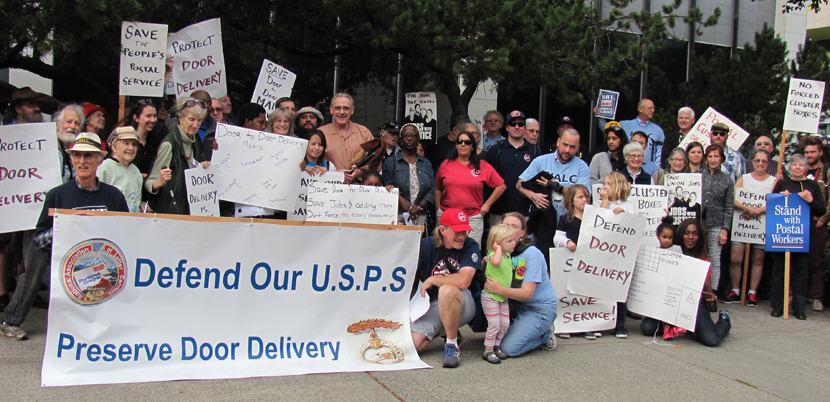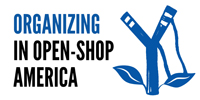How We're Surviving Right to Work: Letter Carriers Keep Numbers up with Shop Floor Action

How does Letter Carriers Branch 82 in Portland, Oregon, keep its membership at 95 percent despite being an open shop? Photo: Jamie Partridge
Postal unions, like all federal employee unions, are open shop. That means workers can get the benefits of union representation while opting out of paying dues.
Yet the postal unions generally maintain high rates of voluntary union membership—and Letter Carriers Branch 82 in Portland, Oregon, does even better than most. From 90 percent membership five years ago, it has “slowly up-ticked,” says Organizing Chair Willie Groshell, to around 95 percent of the 1,200 represented carriers.

How did they raise that number so high? It’s mostly the work of volunteers like Groshell, who delivers the mail full-time. (Three top officers make up the branch’s full-time staff.)
Most new hires sign up right away at orientation, where the branch vice president spends up to two hours with them—the union has this right guaranteed in its contract—talking through the union’s history and what to expect. One perk is getting immediate access to the union’s uniform closet, since the Postal Service won’t provide a uniform allowance until your probation is up.
But beyond that, “it’s an easy sell for us in Branch 82, because we defend our contract extremely well,” Groshell says.
PLENTY OF GRIEVANCES
One key is a robust network of stewards who involve almost all members in filing and pursuing grievances. Every year, Groshell estimates, 98 percent of Portland letter carriers get the equivalent of their entire dues back in grievance settlements.
Short-staffing is the rule in post offices across the country. But “we are, I think, the only place in the country that has specific language about delivery after dark,” Groshell says. “If we have to be out after sunset, it triggers a grievance payment of $50 for each incident.” That adds up, especially in the winter when the sun sets early and there are lots of holiday packages to deliver.
Enforcing those penalties requires “eyes and ears on the work room floor almost every place, every day,” Groshell says. The large stations with 100 or more letter carriers have four or more stewards apiece, and even smaller stations mostly have at least one. “We control the environment on the work floor.”
UNION IN ACTION
Sometimes exerting that control requires collective action. A few months ago, for instance, carriers at Groshell’s station were told they must deliver three “full coverages” in a single day.
A full coverage is an advertisement that goes to every household, along with the mail. Two of the three were magazine-thick. That’s a lot of weight to carry around all day.
There was general “panic and angst,” Groshell says. So he encouraged everyone to fill out a safety concern form. Some were nervous, but one by one, people filed up to drop their forms on the manager’s desk. About half the carriers on shift that day participated.
And that was all it took. Within minutes the manager agreed to postpone the heaviest item till the next day. Palpable relief and power zipped around the work floor.
“It’s moments like that that really do bring people on board, that get people to understand what we can do collectively,” Groshell says. “You’ve got to find those opportunities, and when they’re there, you’ve got to try and take them.”
One weekend a couple years ago, Branch 82 partnered with the Postal Workers local (APWU)—which represents mail plant workers, drivers, and post office clerks—for a joint internal organizing push. Members went out in pairs to visit non-members at their homes.
More Dispatches from the Front Lines of Right to Work

SUPPORT LABOR NOTES
BECOME A MONTHLY DONOR
Give $10 a month or more and get our "Fight the Boss, Build the Union" T-shirt.
The open shop is the rule for private sector workers in 28 “right-to-work” states, for public sector workers in 25 states, and for federal workers all over this country. That means workers covered by a union contract get to enjoy the benefits of representation without being members or paying dues.
But even in states and sectors where membership is legally optional, some unions have high percentages of workers signed up as members. How do they do it? Read more from:
- Oil refinery workers in Nevada
- Postal workers in Massachusetts
- Teachers in Wisconsin
- Transit workers in Virginia
- Truck factory workers in Indiana
- Transit workers in Tennessee
- Grocery workers in Virginia
- Shipyard workers in Indiana
For a short exercise to help your union start preparing to survive an open shop click here.
For advice on how to orient new hires to the union (and sign them up as members), click here.
The point was to listen. “We weren’t aggressive,” Groshell says. “We just started having conversations to find out, ‘Why aren’t you a member? What are your concerns?’”
Answers ran the gamut. One or two said they’d never been asked. Some had transferred in from other parts of the country and fallen through the cracks.
Others were standoffish at first. “It took a while to convince them we were just here to talk,” Groshell said. “But once they started talking, in most cases there were maybe one or two things in the past that had upset them.”
Some were ready to sign up on the spot. Others needed to see the next step: the union following up to address their problems. “We had to let them know this wasn’t just a one-time thing,” Groshell said. “The key to any organizing is communication. You have to be honest, you have to follow through on whatever you say you’re going to do, and you have to tell people the truth, rather than what you think they want to hear.”
Overall, he says, the activity was fun. It strengthened the relationship between the two unions, and gave members and non-members the chance to talk in the relaxed, frank way that’s easier when you’re not at work.
AN EVERYDAY PRIORITY
Now the union keeps stewards in each station apprised which of their co-workers are non-members, and encourages them “every so often,” Groshell says, “to ask them why.”
The idea is to have “respectful, productive conversations,” he says. “You’re not going to get people to join by belittling them. At the same time we want to make sure they can’t hide in the shadows.”
It also matters who’s doing the asking. In annual training on non-member sign-up, stewards are encouraged to recognize workplace social circles. “We talk about figuring out who the people in the station are that have the relationship already with the non-members, and encouraging those people to be the ones having the conversations,” Groshell says.
Nonetheless, changing someone’s mind takes time; it can stretch over many conversations. “Most people don’t just sign up after you talk to them once,” Groshell says. “It’s been made an everyday priority. Everybody knows who the non-members are, and everybody feels empowered to engage them. We try to weave it into the culture.”






